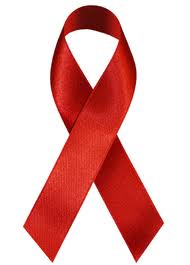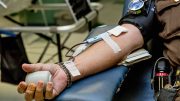In late May, researchers in a major international study reported definitive evidence that early antiretroviral treatment (ART) substantially reduces HIV-infected persons’ risks of developing AIDS or other serious illnesses. In particular, the study showed that people who start ART when their CD4 T-cell counts are relatively high (a key measure of immune system health) have better health outcomes than those who delay treatment until their CD4 cell counts drop to lower levels. Together with data from earlier studies showing that ART reduces the risk of HIV transmission to uninfected sexual partners, this new information supports offering treatment to everyone infected with HIV.
The recent findings are from the Strategic Timing of AntiRetroviral Treatment (START) study, which began in 2011 and enrolled nearly 4,700 HIV-infected men and women in 35 countries with CD4 cell counts above 500. START’s primary objective was to determine whether taking ART immediately would lower the risk of AIDS, other serious illnesses, or death compared to waiting until a person’s CD4 cell count fell to 350 or lower. “We now have clear-cut proof that it is of significantly greater health benefit to an HIV-infected person to start ART sooner rather than later,” noted Anthony Fauci, director of the National Institute of Allergy and Infectious Diseases. “Moreover, early therapy conveys a double benefit, not only improving the health of individuals but at the same time, by lowering their viral load, reducing the risk they will transmit HIV to others. These findings have global implications for the treatment of HIV.”
In a posting on the blog.AIDS.gov site, Fauci further noted that about 35 million people are currently living with HIV worldwide. In 2013 alone, an estimated 2.1 million persons were newly infected with the virus. “Although the START trial now provides firm scientific proof of the benefits of early initiation of ART, to achieve full viral suppression for all HIV-infected individuals will require addressing a number of care and treatment challenges, including stable access to medications, access to trained health care workers, and achieving the high levels of adherence required for ART effectiveness.”
CDC Awards $216 million for HIV Prevention Work
On July 1, CDC announced the awarding of $216 million over five years to 90 community-based organizations (CBOs) nationwide (including Fenway Health) that are involved in HIV prevention. According to CDC, this funding will support the delivery of effective HIV prevention strategies to those at greatest risk, including people of color, men who have sex with men (MSM), transgender persons, and people who inject drugs. “The organizations we’re funding have a strong foothold in the hardest-hit communities,” noted Jonathan Mermin, director of CDC’s National Center for HIV/AIDS, Viral Hepatitis, STD, and TB Prevention. “They have the credibility and experience needed to deliver the most effective HIV prevention strategies to those who need them most.” CBOs will use the new funding to deliver high-impact HIV prevention strategies, including:
- providing HIV testing to those at high risk to increase the proportion of people who are aware of their HIV status;
- engaging HIV-positive people in ongoing care and treatment, helping them adhere to antiretroviral Therapy, and ensuring they receive prevention and support services;
- ensuring high-risk, HIV-negative individuals have access to prevention and support services such as pre-exposure prophylaxis, post-exposure prophylaxis, high-impact behavioral interventions, and screening for sexually transmitted infections; and
- distributing condoms to HIV-positive and high-risk, HIV-negative individuals.
U.S. Supreme Court Upholds Affordable Care Act Subsidies; Move Will Benefit People with HIV in the South
In a much-anticipated decision, the U.S. Supreme Court ruled on June 25 that health care subsidies under the Patient Protection and Affordable Care Act (ACA) are legal. The 6-3 decision is a major victory for supporters of the ACA and health care reform. In the case known as King v. Burwell, opponents of the law challenged an Internal Revenue Service ruling that, under the ACA, individuals who purchase private health insurance through both federal and state-run health insurance exchanges are eligible for tax subsidies.
“This case had the potential to severely undermine and possibly implode the ACA,” according to analysts at Harvard University’s Center for Law and Health Policy Innovation (CLHPI). “If the challengers had prevailed, potentially five million Americans who recently gained coverage under the ACA would have lost their access to health insurance and health care, and the health insurance industries of 34 States would have been seriously harmed,” CLHPI contends.
“Congress passed the Affordable Care Act to improve health insurance markets, not to destroy them,” Chief Justice John Roberts wrote in the majority opinion. “The combination of no tax credits and an ineffective coverage requirement could well push a state’s individual insurance market into a death spiral. It is implausible that Congress meant the Act to operate in this manner.”
Judge Antonin Scalia sharply disagreed with the Court’s majority in his dissenting opinion, joined by justices Alito and Thomas. He called the majority’s interpretation of ACA’s subsidy language “quite absurd” and argued that “words no longer have meaning if an Exchange that is not established by the State is ‘established by the State.’”
The decision was widely hailed by proponents of health care reform, including the American Public Health Association (APHA). “We are pleased the Court understood the legislative history and intent of this law and ruled in favor of the [Obama] Administration,” according to an APHA statement. “This ruling ensures that health insurance tax credits will remain available in all states and more importantly that health insurance will remain affordable for those people who receive it through the exchanges.”
Scott Schoettes, HIV project director for Lambda Legal, agreed. “The majority ruled to preserve the tax credits and maintain the integrity of the ACA, protecting access for all, including people living with HIV who are low-income, rural, southern, Black, and were―before the ACA―largely uninsured,” Schoettes noted. “No one should be put at greater risk to the ravages of HIV simply because they live in one of the 34 states choosing not to set up its own health insurance exchange.” [pullquote]“No one should be put at greater risk to the ravages of HIV simply because they live in one of the 34 states choosing not to set up its own health insurance exchange.”—Scott Schoettes, HIV project director for Lambda Legal[/pullquote]
July Update on the HIV Outbreak in Rural Indiana
The number of newly reported cases of HIV in rural Scott County in southeastern Indiana has slowed during the past two months, rising from 153 in mid-May to 174 by July 14. Officials from the Indiana State Department of Health (ISDH) are continuing to work with local health departments, health care providers, and others to contain the spread of HIV. Disease intervention specialists are interviewing each newly identified HIV-infected person to obtain information about needle-sharing and sex partners, as well as helping persons connect to care coordination services, medical care, and HIV prevention information.
Eighty-six percent of the HIV-positive persons in the recent outbreak are coinfected with hepatitis C virus (HCV), ISDH officials reported at a mid-June briefing. At that time, 69% were engaged in care and 7% were virally suppressed. Indiana health officials identified two main goals in their continuing response to the outbreak: “1) suppress and sustain suppression of the community viral load; and 2) provide all services vital and necessary to identify and care for HIV-positive individuals and high-risk negatives with the Local Health Department Needle Exchange Program through coordination and collaboration at a local level.”
CDC Reports Track Progress in HIV Testing and Linkage to Care
In conjunction with National HIV Testing Day on June 27, CDC published two new reports on HIV testing, diagnoses, and linkages to care in the Morbidity and Mortality Weekly Report. In the first report, Prevalence of Diagnosed and Undiagnosed HIV Infection – United States, 2008–2012, researchers from CDC and Emory University used HIV surveillance data to estimate the prevalence of diagnosed and undiagnosed HIV infection in U.S. states and the District of Columbia (D.C.) for the period 2008 through 2012. They found that, for the U.S. as a whole, about 87% of persons infected with HIV had been diagnosed with the virus. In the 42 jurisdictions with numerically stable estimates, HIV diagnosis rates ranged from 77% in Louisiana to greater than 90% in Colorado, Connecticut, Delaware, Hawaii, and New York. HIV prevalence rates varied widely, from a low of 110 per 100,000 persons in Iowa to a high of 3,936 per 100,000 persons in D.C. [pullquote]They found that, for the U.S. as a whole, about 87% of persons infected with HIV had been diagnosed with the virus. In the 42 jurisdictions with numerically stable estimates, HIV diagnosis rates ranged from 77% in Louisiana to greater than 90% in Colorado, Connecticut, Delaware, Hawaii, and New York.[/pullquote]
“The results presented in this report show that although the overall percentage of persons living with HIV who have received a diagnosis of HIV infection is high, additional efforts are needed to ensure that all jurisdictions meet the goals of the [National HIV/AIDS] Strategy,” (NHAS) according to the researchers. One key objective of the NHAS is to increase the percentage of persons living with HIV who know their status to greater than 90%. “Continued efforts to implement routine HIV screening in health care settings and focus on targeted testing in non–health care settings to access populations in communities with disproportionately high HIV burden . . . might help further reduce undiagnosed HIV infection.”
In the second report, Identifying New Positives and Linkage to HIV Medical Care – 23 Testing Site Types, United States, 2013, CDC researchers analyzed data for 23 HIV testing site types to determine: 1) the number of HIV tests conducted; 2) the percentage of persons with new diagnoses of HIV infection (referred to as “new positives”); and 3) the percentage of persons who were linked to HIV medical care within 90 days after receiving HIV diagnoses. They found that, in health care settings, primary care, and sexually transmitted disease (STD) clinics accounted for substantially more HIV tests than did other sites, and STD clinics identified more new positives. In non-health care settings, HIV counseling and testing sites accounted for the most tests and identified the highest number of new positives.
To evaluate linkage-to-care rates for different testing site types, the CDC researchers calculated two values: a minimum percentage and a maximum percentage. The minimum percentage consisted of the number of persons linked to care divided by the total number of persons diagnosed, including persons for whom data were missing. The maximum percentage consisted of the number of persons linked to care divided by the total number of persons diagnosed, excluding persons for whom data were missing. According to CDC, the minimum percentages likely underestimate the sites’ actual linkage-to-care performance, while the maximum percentages likely overestimate performance.
“No HIV testing site met the National HIV/AIDS Strategy goal of 85.0% linked to HIV medical care within 90 days of diagnosis based on the minimum percentages calculated,” the researchers noted. However, when they used the maximum percentages for linkage-to-care rates, they found that the goal was met by 8 of the 12 site types among health care settings and 7 of 11 site types among non-health care settings.
“Activities to reduce behavioral risk factors and improve linkage to care are critical to improve health and prevent HIV transmission to partners,” the CDC researchers concluded. “Focusing HIV testing efforts on the most effective sites in both health care and non–health care settings and increasing linkage to medical care could have a large impact on identifying new positives and ensuring that they receive recommended services.”
CDC Issues Revised STD Treatment Guidelines
CDC recently published its new Sexually Transmitted Diseases Treatment Guidelines, 2015 for the care of persons who have or are at risk for sexually transmitted diseases (STDs). According to CDC, the 2015 guidelines include discussions of the following health issues: 1) alternative treatment regimens for gonorrhea; 2) diagnostic tests for trichomoniasis; 3) alternative treatment options for genital warts; 4) the role of Mycoplasma genitalium bacteria in urethritis/cervicitis and implications for treating these conditions; 5) human papillomavirus vaccine recommendations and counseling messages; 6) STD management in transgender persons; 7) annual HCV testing in persons with HIV infection; 8) diagnosis of urethritis; and 9) retesting to detect repeat infection.
CDC has developed several resources to help health care providers access, understand, and use the 2015 guidelines effectively, including:
- Wall Chart – This poster-sized chart provides an overview of the 2015 guidelines, and is designed for use in physician offices, nurses’ stations, and other clinical settings.
- Pocket Guide – This compact summary of the 2015 guidelines can fit in a lab coat, pocket, or desk drawer.
- Apple STD Tx Guide 2015 App – This free app gives providers ready access to STD treatment and diagnostic information. An Android version of the app is expected to be available later this summer.
- Evidence Tables – These background documents provide the basis for the STD screening, diagnostic, and treatment recommendations included in the 2015 STD Treatment Guidelines.
Limited quantities (in print) of the Wall Chart and Pocket Guide may be ordered through CDC’s Information on Demand system.
*Eric Brus is the Director of Health Information at AIDS Action Committee. This report is produced by the Health Library of the AIDS Action Committee in collaboration with the New England AIDS Education and Training Center Minority AIDS Initiative Project. The full version is available online.








